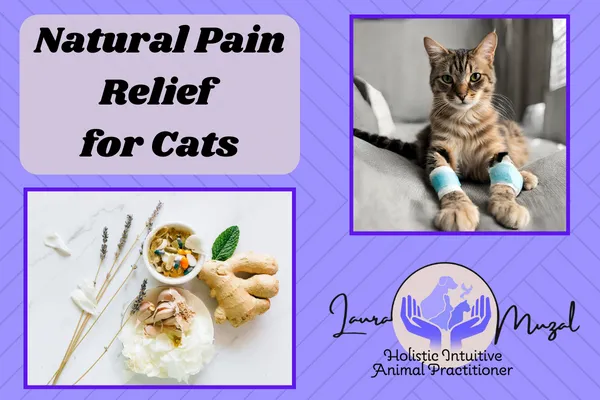Pawsitively Holistic: Your Guide to Pet Wellness

Natural Pain Relief for Cats

Natural Pain Relief for Cats
Cats have evolved to have a remarkable ability to hide their pain as a survival skill. This instinct, rooted in the need to protect themselves from predators, has taught them to endure discomfort silently rather than displaying vulnerability, like crying out when injured.
As a responsible pet parent, it's essential to pay close attention to your cat's body language which is their primary way of expressing discomfort or distress. Though they may not vocalize their pain, they communicate through subtle cues and behaviors.
In the realm of pain relief, natural remedies have emerged as a gentle yet effective approach, offering benefits beyond conventional pharmaceuticals. These remedies harness the healing properties of herbs, essential oils, and other natural elements, providing relief without the risk of adverse reactions. By opting for these alternatives, you're not just easing your cat's pain but also reducing the potential risks associated with traditional medications.
Recognizing Pain in Your Cats
Recognizing the subtle signs of pain in your cat is a vital step in enhancing their quality of life and strengthening your bond. But what signs should you be vigilant about?
Restlessness and Trembling: Unusual restlessness or trembling movements in your cat could indicate underlying discomfort.
Unusual Vocalizations: Cats that are generally quiet might cry, growl, or hiss when in pain or distress.
Difficulty in Movement: If your agile cat struggles with activities like jumping or climbing, it could signal pain in their joints or limbs.
Avoidance of Physical Contact: Cats that are usually affectionate may flinch or avoid being petted when experiencing pain.
Decreased Playfulness: A drop in enthusiasm for playtime could suggest your cat is not feeling well.
Excessive Grooming: Constant licking of a specific area might indicate pain or irritation in that region.
Increased Aggression: Pain can cause uncharacteristic aggression, leading to sudden outbursts or defensive behavior.
Changes in Posture or Gait: Changes in sitting, standing, or walking style, such as stiffness or favoring one side, could indicate pain.
Paying attention to these subtle cues equips you to provide timely care and relief, nurturing a stronger, more empathetic connection with your cherished feline companion. Your vigilance ensures their comfort and underscores your dedication to their well-being, reinforcing the special bond you both share.
Natural Pain Relief Remedies

When it comes to easing the pain of our cherished feline companions, adopting a holistic approach can truly transform their well-being. These natural remedies not only address discomfort but also promote your cat's overall health and happiness.
Herbal Remedies - Cat's Claw and Turmeric for Pain Relief
In the realm of natural pain relief, herbs like Cat’s Claw and Turmeric stand out as a powerful duo. Cat’s Claw, scientifically known as Uncaria tomentosa, is a vine indigenous to the Amazon rainforest. Its bark contains compounds studied for their potential anti-inflammatory and pain-relieving effects.
Similarly, Turmeric, with its active ingredient curcumin, has long been esteemed for its anti-inflammatory properties. When used together, these botanical marvels can offer your feline companion significant relief from pain and discomfort, making them invaluable components of a holistic approach to your pet’s well-being.
Essential Oils - Safe Application for Feline Comfort
Safely used and properly diluted, certain essential oils can serve as effective tools in your cat’s pain relief regimen. For example, scents renowned for their calming effects, such as lavender and chamomile, have the potential to alleviate discomfort. It's crucial to emphasize that not all essential oils are safe for cats. Even the safe ones should be used sparingly and in moderation.

Another option to consider is CBD oil, which has gained popularity as a natural remedy for various ailments, including pain. It interacts with the body's endocannabinoid system, potentially offering relief from discomfort. Both CBD Oil Ease and CBD Oil Heal from CBD Dog Health are products that can provide relief for cats experiencing pain. These items are infused with full-spectrum hemp oil, known for its potential therapeutic benefits. HEAL combines Full Spectrum CBD Oil, Hemp Seed Oil, and MCT Oil in a special blend designed to relieve pain and inflammation. On the other hand, EASE is expertly crafted with turmeric and frankincense, aiming to address a variety of discomforts such as joint pain, arthritis, allergies, and other issues your cat might face. To find out more about these products, click here: CBD Oil Ease for Cats and CBD Oil Heal for Cats.
Massage and Physical Therapy - Gentle Techniques for Alleviating Pain
Physical touch can serve as a powerful source of relief for your cat. Discover gentle massage and therapy methods designed to alleviate discomfort and induce relaxation. These techniques involve delicately applying pressure to specific areas, enhancing circulation, and relieving muscle tension. Moreover, they can trigger the release of endorphins, the body’s natural pain relievers, imparting a sense of tranquility and ease to your cat. When integrated into their wellness routine, these therapies can significantly improve their overall quality of life, granting them a heightened sense of comfort and contentment. Always approach these techniques with tenderness and patience, carefully observing your cat’s cues to ensure their well-being and comfort.
Proper Nutrition for Pain Management - Fueling Relief through Diet

The role of diet is crucial in ensuring your cat’s overall health and well-being, particularly in managing pain. Providing your pets with anti-inflammatory foods can play a significant role in reducing body inflammation and enhancing their comfort. Opt for whole, minimally processed foods such as fruits, vegetables, whole grains, legumes, nuts, and seeds.
Focus on incorporating colorful fruits and vegetables into their diet, as they are abundant in antioxidants and phytochemicals that combat inflammation. A healthy diet like The CrockPet Diet stands out as an excellent choice, as it includes a variety of anti-inflammatory foods in its ingredients. Access the recipe and dietary tips specifically designed to support your cat’s journey towards relief.
Home Comforts for Pain Relief - Creating a Haven of Tranquility
Creating a stress-free environment is essential for a cat experiencing pain. Discover ways to transform your surroundings into a warm sanctuary that encourages healing and comfort. From comfortable corners to soothing elements, our guide will help you establish an atmosphere that nurtures your cat during their recovery. Find out how you can support your pet at home by reading our blog post Emergency Kit for Your Pet.
Key Takeaways
After introducing your cat to a natural remedy, it's crucial to observe their response closely. Pay attention to any changes in behavior, comfort, or mobility. Are there signs of improvement or any adverse reactions? Document these observations as they are vital in assessing the remedy's effectiveness and deciding if adjustments are necessary. Additionally, maintain open communication with your veterinarian or holistic pet health coach. Providing regular updates on your cat’s progress enables well-informed decisions regarding their ongoing care.
Natural remedies offer numerous benefits for our beloved feline companions. They not only alleviate pain but also enhance overall well-being. Compared to pharmaceuticals, these methods come with fewer risks of side effects, providing a safer approach to pain management. By opting for natural options, you're embracing a holistic approach that nurtures your cat’s physical and emotional health.
Frequently Asked Questions About Dog Grooming
Can I administer a human painkiller to my cat?
No, it's essential never to give your cat a human painkiller without explicit guidance from a veterinarian. Many human pain medications, including over-the-counter ones, can be extremely dangerous and potentially fatal for cats. Cats have different metabolisms and sensitivities compared to humans, so substances safe for us can be highly toxic to them.
Is there a way to assess pain levels in cats?
Yes, there is. The Feline Musculoskeletal Pain Index, or FMPI, is a tool designed to help gauge the extent of pain experienced by our feline companions. The FMPI not only measures the degree of pain your cat is enduring but also provides results that can be documented and discussed during your next veterinary visit.
Is there a device I can use at home to help alleviate my cat's pain?
Yes! The PEMF pads for pets utilizes specific wave patterns designed to accelerate healing, minimize inflammation, and alleviate pain and swelling. This therapy is safe and effective, requiring no invasive procedures or medications. Notably, this technology has received FDA approval for use in humans as well.
Have More Questions or Need Personalized Pet Care Advice?
If you have additional questions or need personalized guidance for your beloved pet, I'm here to help. Book a call with me, and let's discuss how to best care for your furry friend. Your pet's well-being is my priority, and I'm dedicated to providing the support and expertise you need. Click here to schedule your consultation today. Together, we can ensure your pet leads a happy, healthy life.
Affiliate Disclosure: Some of the links on this blog are affiliate links. If you make a purchase through these links, the blog owner may earn a commission at no extra cost to you.

